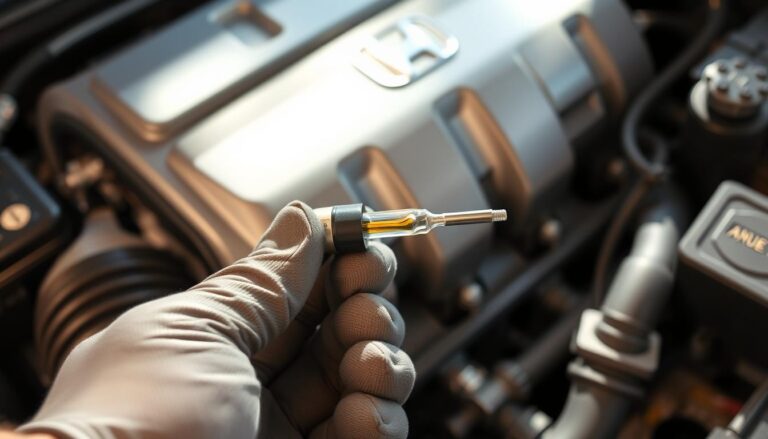Maintaining the correct transmission fluid capacity is crucial for the optimal performance and longevity of your Honda CR-V.
The transmission fluid plays a vital role in lubricating the transmission components, regulating temperature, and facilitating smooth gear shifts.
Neglecting transmission maintenance can lead to premature wear, decreased fuel efficiency, and potentially costly repairs.
Key Takeaways
- Understand the importance of maintaining the correct transmission fluid capacity in your Honda CR-V.
- Learn how to check and replace transmission fluid in your vehicle.
- Discover the recommended transmission fluid type for your Honda CR-V.
- Follow a step-by-step guide to ensure proper transmission maintenance.
- Improve your vehicle’s performance and longevity.
Understanding Transmission Fluid Importance for Your Honda CR-V
Transmission fluid plays a crucial role in the smooth operation of your Honda CR-V’s transmission system. It is essential for lubricating the transmission’s components, regulating temperature, and facilitating smooth gear shifts.
The Function of Transmission Fluid in Your Vehicle
Transmission fluid serves several critical functions in your Honda CR-V. It lubricates moving parts to reduce wear and tear, regulates temperature to prevent overheating, and enhances performance by ensuring smooth gear transitions. Using the correct type of transmission fluid is vital for maintaining your vehicle’s health.
Types of Transmission Systems in Honda CR-V Models
Honda CR-V models come equipped with various transmission systems, including automatic and manual transmissions. The type of transmission fluid required can vary depending on the transmission type and model year. Some common types include:
- Conventional automatic transmission fluid
- Synthetic transmission fluid for improved performance
- CVT (Continuously Variable Transmission) fluid for specific models
Warning Signs of Low or Degraded Transmission Fluid
Low or degraded transmission fluid can lead to serious issues with your Honda CR-V’s transmission. Warning signs include:
- Slipping or hesitation between gears
- Unusual noises, such as grinding or whining
- Leaks or signs of fluid degradation
Regular checks can help identify these issues early, preventing costly repairs.
Honda CR-V Transmission Fluid Capacity Specifications
To keep your Honda CR-V running smoothly, it’s essential to know the transmission fluid capacity for your specific model. The transmission fluid capacity can vary significantly depending on the model year and the type of transmission your vehicle is equipped with.
1997-2001 First Generation (Manual vs. Automatic)
For the first generation Honda CR-V (1997-2001), the transmission fluid capacity differs between manual and automatic transmissions. The manual transmission holds approximately 2.4 liters (2.5 quarts) of fluid, while the automatic transmission requires about 3.1 liters (3.3 quarts).
2002-2006 Second Generation Capacity Requirements
The second generation Honda CR-V (2002-2006) has slightly different requirements. For manual transmissions, the capacity remains around 2.4 liters (2.5 quarts), but for automatic transmissions, it increases to approximately 3.7 liters (3.9 quarts).
2007-2011 Third Generation Specifications
In the third generation (2007-2011), Honda CR-V models with manual transmissions still require about 2.4 liters (2.5 quarts) of transmission fluid. However, models equipped with automatic transmissions need around 3.9 liters (4.1 quarts).
2012-2016 Fourth Generation Fluid Volumes
For the fourth generation (2012-2016), the manual transmission fluid capacity remains at 2.4 liters (2.5 quarts), while the automatic transmission capacity is approximately 3.7 liters (3.9 quarts).
2017-Present Fifth Generation Requirements
The fifth generation Honda CR-V (2017-present) continues with similar specifications: 2.4 liters (2.5 quarts) for manual transmissions and about 3.5 liters (3.7 quarts) for CVT (Continuously Variable Transmission) models.
| Model Year | Transmission Type | Fluid Capacity (Liters) | Fluid Capacity (Quarts) |
|---|---|---|---|
| 1997-2001 | Manual | 2.4 | 2.5 |
| 1997-2001 | Automatic | 3.1 | 3.3 |
| 2002-2006 | Manual | 2.4 | 2.5 |
| 2002-2006 | Automatic | 3.7 | 3.9 |
| 2007-2011 | Manual | 2.4 | 2.5 |
| 2007-2011 | Automatic | 3.9 | 4.1 |
| 2012-2016 | Manual | 2.4 | 2.5 |
| 2012-2016 | Automatic | 3.7 | 3.9 |
| 2017-Present | Manual | 2.4 | 2.5 |
| 2017-Present | CVT | 3.5 | 3.7 |
How to Check Transmission Fluid Levels in Your Honda CR-V
Checking the transmission fluid level in your Honda CR-V is a crucial maintenance task that ensures the longevity of your vehicle’s transmission system. Regular checks can help identify potential issues before they become major problems.
Locating the Dipstick or Level Plug
The first step in checking your Honda CR-V’s transmission fluid level is locating the dipstick or level plug. For most models, the transmission dipstick is labeled and can be found under the hood. However, some models may have a level plug located on the transmission itself, which requires a different approach.

Proper Vehicle Preparation for Accurate Readings
To get an accurate reading, your Honda CR-V should be parked on a level surface. The engine should be running, and the transmission should be in park (for automatic transmissions) or neutral (for manual transmissions). This ensures that the fluid level reading is accurate.
Reading and Interpreting Fluid Levels
Once you’ve located the dipstick or level plug, check the fluid level according to the manufacturer’s specifications. The dipstick will have markings indicating the minimum and maximum levels. The fluid level should be between these two marks.
Assessing Fluid Quality and Condition
In addition to checking the fluid level, it’s also important to assess the quality and condition of the transmission fluid. The fluid should be a certain color (usually pink or red for new fluid) and should not have a burnt smell. If the fluid is dark or has a burnt odor, it may be a sign that the fluid needs to be changed.
| Fluid Condition | Color | Smell | Action |
|---|---|---|---|
| Good | Pink or Red | No burnt smell | No action needed |
| Degraded | Dark or Brown | Burnt smell | Change fluid |
Complete Guide to Changing Honda CR-V Transmission Fluid
Changing the transmission fluid in your Honda CR-V is a crucial maintenance task that ensures the longevity of your vehicle’s transmission system. Regularly changing the transmission fluid helps to lubricate the moving parts, prevent corrosion, and maintain the overall health of the transmission.
Tools and Materials Needed
To change the transmission fluid in your Honda CR-V, you’ll need a few essential tools and materials. These include a socket wrench or ratchet, a drain pan, new transmission fluid that meets the Honda CR-V specifications, and a replacement transmission filter (if your model is equipped with one). It’s also a good idea to have some rags on hand to clean up any spills.
Preparing Your Vehicle
Before you start, make sure your Honda CR-V is parked on a level surface and apply the parking brake. It’s also recommended to check your owner’s manual for any specific instructions or precautions related to changing the transmission fluid in your particular model.
Draining the Old Fluid
To drain the old transmission fluid, locate the drain plug and use a socket wrench to remove it. Be prepared for the fluid to drain out quickly, and make sure the drain pan is positioned correctly to catch the fluid. Once the fluid has stopped dripping, replace the drain plug and tighten it to the specified torque.

Replacing the Transmission Filter (If Applicable)
If your Honda CR-V is equipped with a transmission filter, now is the time to replace it. Consult your owner’s manual or a repair manual for instructions on how to access and replace the filter. A new filter will help ensure that the new transmission fluid remains clean and effective.
Adding New Fluid to Proper Capacity
After draining the old fluid and replacing the filter (if applicable), it’s time to add new transmission fluid. Use a funnel to pour in the new fluid, and refer to your owner’s manual or the specifications section earlier in this article to determine the correct capacity and type of fluid to use.
Verifying Fluid Levels After Completion
Once you’ve added the new fluid, start the engine and let it run for a few minutes. Then, check the transmission fluid level using the dipstick or level plug. Ensure that the level is at the recommended level, and top off as necessary.
Common Mistakes to Avoid
When changing the transmission fluid in your Honda CR-V, avoid common mistakes such as overfilling or underfilling the transmission, not tightening the drain plug securely, and not using the correct type of transmission fluid. These mistakes can lead to problems with your transmission, so it’s essential to be meticulous during the process.
Conclusion
Proper transmission fluid maintenance is crucial for the longevity and performance of your Honda CR-V. As discussed in this guide, understanding the transmission fluid capacity, checking fluid levels, and changing the fluid as needed are essential steps in maintaining your vehicle’s transmission.
By following the steps outlined in this guide, you can ensure that your Honda CR-V’s transmission operates smoothly, reducing the risk of costly repairs down the line. Regular Honda CR-V transmission maintenance is key to extending the life of your vehicle.
The importance of transmission fluid cannot be overstated. It plays a critical role in lubricating the transmission’s components, regulating temperature, and facilitating smooth gear shifts. Neglecting transmission fluid maintenance can lead to premature wear and potentially catastrophic failures.
By staying on top of Honda Cr V Transmission Fluid Capacity and maintenance, you can enjoy a reliable and efficient driving experience. Take the knowledge gained from this guide and apply it to your vehicle’s maintenance routine to ensure its continued performance and longevity.
FAQ
What is the recommended transmission fluid capacity for my Honda CR-V?
The recommended transmission fluid capacity varies by model year and transmission type. For specific capacities, refer to the section on Honda CR-V Transmission Fluid Capacity Specifications.
How often should I check the transmission fluid level in my Honda CR-V?
It is recommended to check the transmission fluid level every 30,000 to 60,000 miles, or as specified in your owner’s manual. Regular checks can help identify potential issues early.
What are the signs of low or degraded transmission fluid in my Honda CR-V?
Signs of low or degraded transmission fluid include slipping or hesitation between gears, unusual noises, and a burning smell. If you notice any of these symptoms, check your transmission fluid level and condition.
Can I use any type of transmission fluid in my Honda CR-V?
No, it’s essential to use the correct type of transmission fluid as specified in your owner’s manual. Using the wrong type can damage your transmission.
How do I know if my Honda CR-V has a manual or automatic transmission?
Check your vehicle’s documentation or the manufacturer’s label on the transmission to determine if it’s manual or automatic. This information is also available in your owner’s manual.
What is the difference between synthetic and conventional transmission fluid?
Synthetic transmission fluid offers better performance in extreme temperatures and can last longer than conventional fluid. However, it’s more expensive. Check your owner’s manual to see if synthetic fluid is recommended for your Honda CR-V.
Can I change the transmission fluid in my Honda CR-V myself?
Yes, you can change the transmission fluid yourself by following the steps outlined in the Complete Guide to Changing Honda CR-V Transmission Fluid. However, if you’re not comfortable with the process, consider consulting a professional mechanic.
What are the benefits of regular transmission fluid changes?
Regular transmission fluid changes can help maintain your vehicle’s performance, prevent damage to the transmission, and extend its lifespan.
How long does it take to change the transmission fluid in a Honda CR-V?
The time it takes to change the transmission fluid can vary depending on your level of experience and the tools available. On average, it can take around 1-2 hours to complete the process.


